Extreme Dreamliner!
:: A suite of new technologies has been incorporated into a next generation wide-body jet that will be the first ever to use composite materials in an attempt to build the most fuel efficient passenger transporter on the planet!
++ Aviation Tech: Seattle, Washington, USA / Everett Facility / Boeing Commercial Airplanes
Is big always beautiful? The new Airbus A380 commences service this year. It is a space guzzler. It needs more runway to clear the ground, more taxi-way for the sweep of its enormous wingspan, and boarding gates have to be re-tasked in order to deal with the logistics of deplaning 800 people from a towering double-decker.
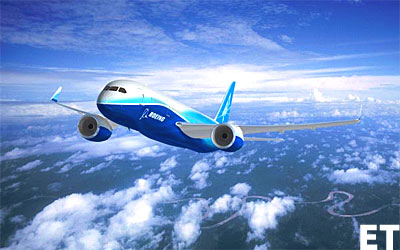 Boeing believes large capacity aircraft flying to big, overcrowded, dispersal “hubs” to be things of the past. Travellers want speed and direct connections. The Boeing 787 Dreamliner is the result of Boeing’s new beliefs. The aircraft is swift and fuel efficient, it is smaller and can access regional airports.
Boeing believes large capacity aircraft flying to big, overcrowded, dispersal “hubs” to be things of the past. Travellers want speed and direct connections. The Boeing 787 Dreamliner is the result of Boeing’s new beliefs. The aircraft is swift and fuel efficient, it is smaller and can access regional airports.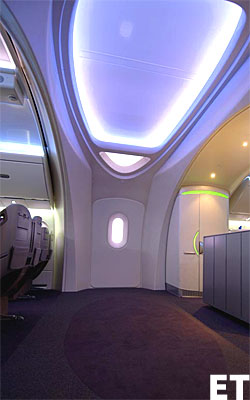 Welcome to the new Boeing 787 Dreamliner! The interior designers understand fully that first impressions can be everlasting. Therefore, they've designed a larger, more open entryway with sweeping arches that immediately direct the eye upward.
Welcome to the new Boeing 787 Dreamliner! The interior designers understand fully that first impressions can be everlasting. Therefore, they've designed a larger, more open entryway with sweeping arches that immediately direct the eye upward.The Boeing 787 Dreamliner "family" (models 3-10) will carry 210 - 350 passengers on routes of 3,000 to 8,800 nautical miles (5,550 to 16,300 kilometers), depending on the model. The various models are expected to enter into service from 2008 to 2010.
The airplane will use 20 percent less fuel for comparable missions than today's similarly sized airplane. Yet it will also travel at speeds similar to today's fastest wide bodies (Mach 0.85). And it will do so with more cargo revenue capacity.
Passengers will also see improvements with the new airplane, from an interior environment with higher humidity to increased comfort and convenience throughout.
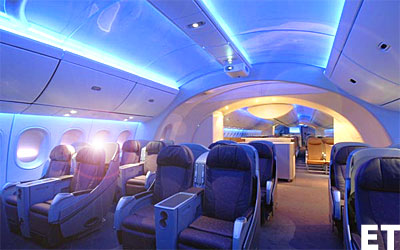 The Boeing 787 Dreamliner's new interior will create a new sensation for passengers inside the cabin. Illuminated by arrays of light emitting diodes, both the brightness and the color of the sky-like cabin ceiling can be controlled in flight by the crew. Flight attendants can give passengers a sense of daylight when desired, and when they want to help passengers rest, simulate a beautiful nighttime sky.
The Boeing 787 Dreamliner's new interior will create a new sensation for passengers inside the cabin. Illuminated by arrays of light emitting diodes, both the brightness and the color of the sky-like cabin ceiling can be controlled in flight by the crew. Flight attendants can give passengers a sense of daylight when desired, and when they want to help passengers rest, simulate a beautiful nighttime sky.Other innovations include sweeping arches, wider aisles, larger lavatories, larger windows (extending above seatback height, the windows offer a view of the horizon to passengers seated anywhere in the cabin), and larger overhead storage bins. All these innovations are designed with the goal to make the passenger feel more connected and comfortable with the flying experience.
Another very cool innovation are the electrochromatic windows which require no shades and can be darkened at the touch of a button.
Note From Technophile: An open architecture will be at the heart of the 787's systems, which will be more simplified than today's airplanes and offer increased functionality. For example, the team is looking at incorporating monitoring systems that will allow the airplane to report maintenance requirements to ground-based computer systems. It is expected that advances in engine technology will contribute as much as 8 percent of the increased efficiency of the new airplane, representing a nearly two-generation jump in technology. New technologies and processes are in development to help Boeing and its supplier partners achieve unprecedented levels of performance at every phase of the program. For example, by manufacturing a one-piece fuselage section, they will eliminate 1,500 aluminum sheets and 40,000 - 50,000 fasteners. The Boeing board of directors granted authority to offer the airplane for sale in late 2003. Program launch occurred in April 2004 with a record order from All-Nippon Airways. Since that time, 29 customers have placed orders and commitments for 393 airplanes from five continents of the world, making this the most successful launch of a new commercial airplane in Boeing's history!:: Source: [Boeing Commercial Airplanes]
:: Image Credits: [Boeing Photos]
:: Innovation: Unparalleled performance, fuel economy and passenger comfort in a next generation wide-body passenger jet designed by an international technology development team.
:: Available: 2008 - 2010 (depending on the model).
:: Cost: USD $120 million per aircraft.
"Qantas has committed a potential US$18 billion for up to 115 of the sleek B787s with the first 65 coming on line from 2008. " ~Smart Travel Asi
 Note from Dan Lelevier, ET (Extreme Technology) Consumer Product Advisor: Just as Boeing is an innovative airliner designer and builder, WestJet is and innovative Airline. WestJet is Canada's leading low-fare airline offering scheduled service throughout its 34-city North American network. Named Canada's most respected corporation for customer service in 2005, WestJet pioneered low-cost high-value flying in Canada, and is known and respected for its modern, comfortable jets. To make a reservation, just click on the banner below. Happy and smart flying!
Note from Dan Lelevier, ET (Extreme Technology) Consumer Product Advisor: Just as Boeing is an innovative airliner designer and builder, WestJet is and innovative Airline. WestJet is Canada's leading low-fare airline offering scheduled service throughout its 34-city North American network. Named Canada's most respected corporation for customer service in 2005, WestJet pioneered low-cost high-value flying in Canada, and is known and respected for its modern, comfortable jets. To make a reservation, just click on the banner below. Happy and smart flying!

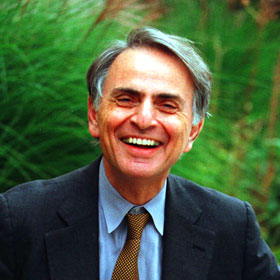
















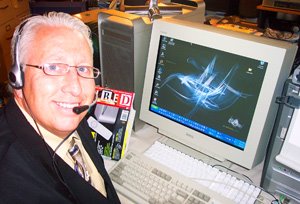
1 Comments:
The Boeing 787 Dreamliner is one of the best commercial projects that I have ever seen ... And the next 747 generation wil be simply the best one. I feel shocked everytime I see an US airliner buying plains from Airbus ...
Post a Comment
<< Home